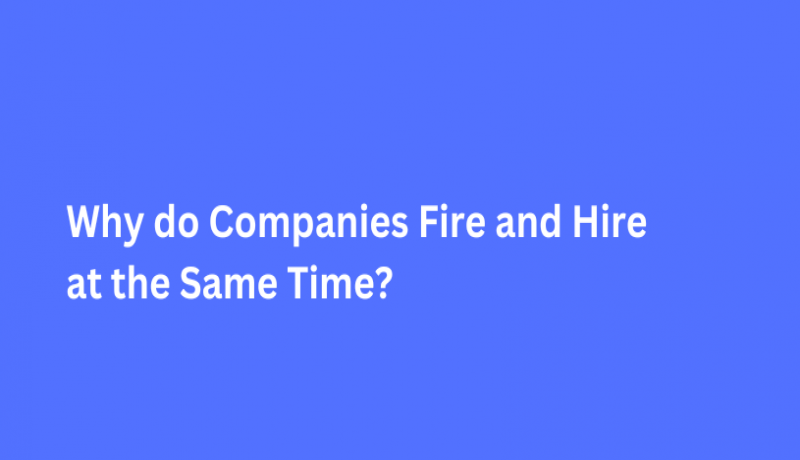Why do Companies Fire and Hire at the Same Time?
Companies may engage in simultaneous hiring and firing for various reasons, and the specific circumstances can vary based on the organization's needs, strategies, and external factors.
It's important to note that the decision to hire or fire is influenced by various factors, including market conditions, company performance, strategic goals, and industry trends.
The decision-making process involves a complex evaluation of internal and external factors to maintain competitiveness and sustainability.
Additionally, organizations may implement these changes for different purposes, such as optimizing efficiency, cutting costs, or adapting to evolving business landscapes. The specifics can vary widely, and each case is unique to the circumstances of the individual company.
Here are some common reasons:
Restructuring: Companies may undergo restructuring or reorganization to adapt to changes in the business environment. This could involve eliminating certain positions or departments while creating new ones that align better with the company's goals and market demands.
Cost-cutting: Firing employees might be part of a cost-cutting strategy, especially during challenging economic times. At the same time, the company may be hiring in areas where they see potential for growth or where specific skills are needed.
Skill gaps: Companies may identify skill gaps within their existing workforce and decide to let go of employees who lack the necessary skills. Simultaneously, they may be hiring new talent with the required expertise.
Mergers and acquisitions: In the case of mergers or acquisitions, duplicate roles may be eliminated to streamline operations. However, the acquiring company might still need to fill key positions or bring in new talent to support the integrated organization.
Strategic shifts: Companies might undergo strategic shifts in their business models, products, or services. This can lead to the elimination of roles that are no longer aligned with the new strategy and the hiring of employees who can contribute to the company's revised objectives.
Performance issues: Terminating underperforming employees is a common practice. Simultaneously, the company may be hiring individuals who possess the skills and capabilities needed to improve overall performance.
Technology advancements: Automation and technological advancements can lead to the displacement of certain jobs. Companies might let go of employees whose roles become obsolete while hiring individuals with expertise in emerging technologies.
Market demand: Changes in market demand for specific products or services may prompt companies to adjust their workforce. This could involve hiring in areas with increased demand and letting go of employees in areas facing decreased demand.
Specific examples can be challenging to pinpoint without real-time data, but industries that frequently experience shifts in workforce dynamics, such as technology, retail, and finance, often engage in simultaneous hiring and firing.
Here are a few general examples:
Tech Industry: Technology companies often experience rapid changes in their product development cycles and market demands. As they innovate and adapt to new technologies, they may hire new talent with specific skills while letting go of employees whose roles become redundant.
Retail Sector: Retail companies may hire seasonal workers during peak times, such as holidays or major sales events, and then reduce the workforce once the demand decreases. Additionally, restructuring within retail organizations might lead to both hiring and firing as they adjust to changes in consumer behavior and market trends.
Financial Services: In the finance industry, companies may adjust their workforce based on economic conditions, market fluctuations, and regulatory changes. They might hire experts in emerging financial technologies or compliance while downsizing in areas where traditional roles are becoming less relevant.
Startups: Startups often operate in a dynamic environment where they need to scale rapidly to meet growth targets. This can involve hiring in areas crucial for expansion and, simultaneously, reevaluating existing positions that may no longer align with the evolving business strategy.
Manufacturing: In manufacturing, automation and technological advancements can lead to workforce adjustments. Companies may hire employees with skills in robotics or artificial intelligence while reducing the number of workers in manual labor roles.
In summary, companies often engage in simultaneous hiring and firing to adapt to changing circumstances, reallocate resources, and ensure that their workforce aligns with their current and future business objectives.
It's not uncommon for companies to hire and fire employees at the same time, and various businesses may go through this process for different reasons.
Your Resume Needs an Upgrade!
Our Executive Resume Writing Service is designed for leaders like you, who are aiming to elevate their careers to new heights. Upgrade with professional experts to industry recognized formats, fonts, text, content and pleasing design.
Whether you're pursuing a new career opportunity, seeking a promotion, or aiming for a more rewarding role, we are here to help you achieve your goals.
Get started - https://executiveresumewriting.c-suitecvsecure.com/
Career Advice
Career Advice
Why is It Important to be Visible in Your Organization?
Traits to Look for in a Professional Mentor
Why Should Senior Executives Use a Professional Resume Writing Service
17 Evidence-Based Strategies to Achieve Work-Life Balance
Things to Do When You Feel your Career is Stuck
How to Ask for a Promotion In 2024 and Actually Get It
Feeling Burned Out at Work? Here's How to Cope
How to Navigate Office Politics
How to Communicate Effectively with Senior Executives in Your Organization
How to Deal with a Bad Boss and Thrive
Navigating the Maze: Strategies for Thriving in a Toxic Work Environment
How to Maximize Time and Efficiency in a Business Conference
How to Write a LinkedIn InMail Seeking Job Opportunities: With Templates
How to Write a Great LinkedIn Summary in 2024
How Long Does It Take a Startup CEO to Build a Successful Business
What is Application Tracking System (ATS) in Recruitment and How to Create an ATS Friendly Resume
How to Write an Executive Resume
17 Key Points to Avoid in an Executive Resume
15 Executive Resume Mistakes You Should Fix Today
Inevitable Components of an Executive Resume
How to Address Job Gaps in Your Resume
How to Explain Layoff in Your Resume
How to Negotiate Salary When You are Offered a Job
Salary Negotiation for C-Suite Executives
7 reasons Why Recruiters Are Ignoring You Even After Interviews
How to Prepare for a Psychometric Assessment
20 Top Phone Interview Tips to Make a Good Impression
Why do Companies Fire and Hire at the Same Time?
What is Organizational Restructuring and How to Deal with an Organizational Restructuring
How to Deal with Job Insecurity
15 questions to Ask Yourself Before an Executive Panel Interview
Why does the Unemployed Find it Difficult to Land a Job








